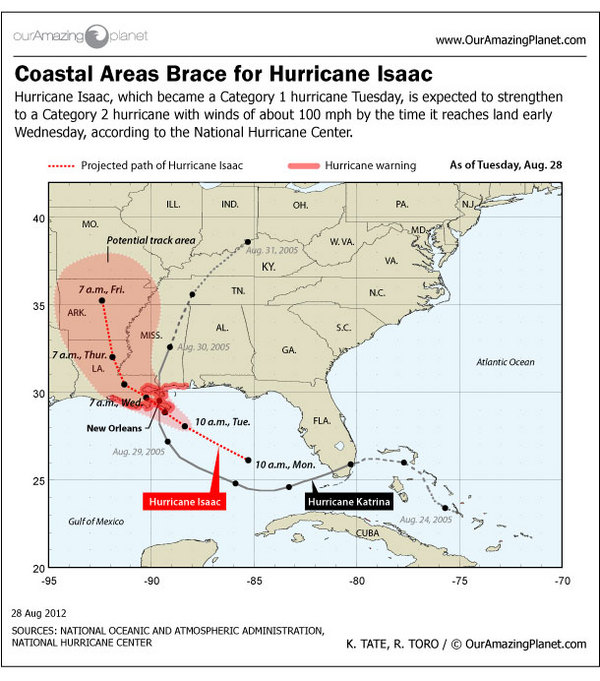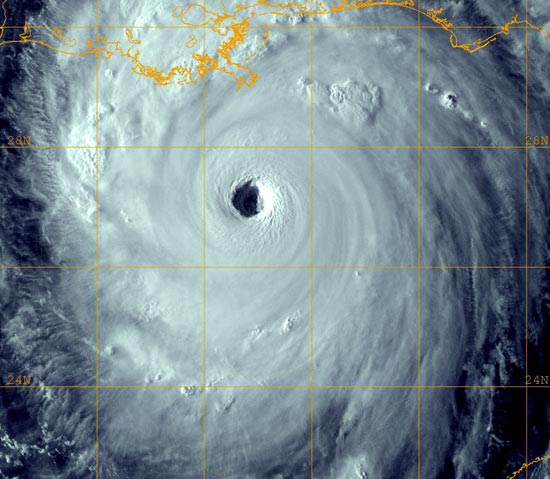
Isaac vs. Katrina: How Do They Compare?

As Hurricane Isaac bears down on the city of New Orleans, gaining strength as it churns across the warm, energizing Gulf of Mexico, it conjures memories of another storm that spiraled in its place almost exactly seven years ago: Hurricane Katrina.
With Katrina, we know how the story ended: in devastation, heartbreak and enormous loss of life and property. With Hurricane Isaac, the story has only begun. There are eerie similarities between the storms — their paths, their threat to New Orleans and the time of year — but there are plenty of important ways that Isaac differs from Katrina.
A side-by-side comparison of these hurricanes, and the Gulf Coast's readiness for each of them, can yield insight into how Isaac's story might play out.
Birth date and place
Isaac: Isaac churned to life over ocean waters east of Puerto Rico. The National Hurricane Center named the storm on Aug. 21, making it the ninth named storm of the 2012 Atlantic hurricane season. A storm is named only after it becomes a tropical storm — defined as an organized, rotating storm with maximum sustained winds of at least 39 mph (63 kph).
A tropical storm becomes a hurricane once its top winds hit at least 74 mph (119 kph). Isaac passed that mark midday today (Aug. 28), becoming the fourth hurricane of 2012.
Katrina: Katrina gained strength much more rapidly than Isaac. The storm was named Aug. 24, 2005, when it was a tropical storm about 65 miles (105 km) east-southeast of Nassau in the Bahamas. Katrina became the fifth hurricane of the 2005 Atlantic season when it was upgraded the very next day.
Get the world’s most fascinating discoveries delivered straight to your inbox.
Storm path
Isaac: Almost from the moment it formed, Isaac has chugged toward the U.S. Gulf Coast, aiming for New Orleans. It veered slightly left early on to sweep over Puerto Rico, the Dominican Republic, Haiti and Cuba, but then made a straight shot northwest across the Gulf of Mexico, drenching Florida en route. Isaac's path is projected to take it to a landfall along the southeast coast of Louisiana. It is then projected to move inland over Arkansas and Missouri and then possibly over the northern Midwest.
Katrina: Katrina took a more curvaceous path. The hurricane made landfall in southeast Florida on Aug. 25, then peeled westward through the Gulf of Mexico. It gained strength for a few days from the warm waters, then arced north to the coast.
Katrina made its Gulf landfall on the morning of Aug. 29 near Buras, La., about 50 miles (80 km) southeast of New Orleans. The storm kept weakening as it moved north, finally dying out around the Great Lakes region Aug. 31. [In Photos: Gulf Coast Damage from Hurricane Katrina]
Size
Isaac: Isaac is bigger than most storms, measuring more than 400 miles (644 km) wide as of Aug. 27. (Typical hurricanes measure 300 miles, or 483 km, across.) Isaac's extra girth will mean more rainfall when it bears down on the coast, as well as a strong storm surge, or rise in the seawater level beneath the storm caused by its winds. The National Hurricane Center predicts up to 20 inches (50 centimeters) of rainfall in some places and a storm surge as high as 12 feet (3.5 meters).
Katrina: The 2005 storm was similarly sized. Katrina measured about 400 miles (644 km) wide when it made landfall in Louisiana.
Incidentally, the biggest hurricane ever recorded was Typhoon Tip. (Hurricanes in the western Pacific Ocean are called typhoons.) The 1979 storm, which made landfall in southern Japan, was nearly 1,400 miles (2,253 km) wide at one point. That's almost half the size of the continental United States. [Hurricanes from Above: See Nature's Biggest Storms]
Intensity
Isaac: Isaac has not grown in intensity as much or as rapidly as predicted. It stayed a tropical storm for a week, then finally reached the status of Category 1 hurricane today, when its maximum sustained winds picked up to 75 mph (121 kph).
Katrina: Katrina was much more intense. In the Gulf of Mexico, Katrina grew into a Category 5 hurricane — the strongest storm category there is. Its maximum sustained winds reached speeds of around 173 mph (278 kph), and then slowed before making landfall. When it hit Louisiana, the storm had been downgraded to a Category 3 hurricane and boasted maximum wind speeds around 127 mph (204 kph), still a major hurricane.
Impact?
Isaac: Isaac has already damaged 2,346 homes, destroyed 335, and caused 24 deaths in Haiti.It is too early to gauge the hurricane's impact on the U.S. Gulf Coast, but some predictions can be ventured.
New Orleans, for one, has probably never been better prepared for a hurricane. Since 2005, the Army Corps of Engineers has spent $14.45 billion overhauling the city's flood prevention system, including raising the height of the levees (sloped embankments), constructing heavily reinforced floodwalls along the canals, and installing a new system of pump stations, including one flood pump capable of sucking 150,000 gallons (more than 560,000 liters) of water per second out of the bowl-like city, should flooding occur.
The rest of the Gulf Coast region may fare less well. Forecasters predict extreme rainfall, and coastal Mississippi, Alabama and Louisiana may experience flooding and destruction of property from flash floods and storm surge. Areas farther inland are also susceptible to flash floods from Isaac's rains, which could total more than 20 inches in some places. However, memories of Katrina have made officials extra cautious, and many areas have been evacuated to prevent loss of life.
Katrina: Katrina was an epic disaster. The hurricane flattened and flooded much of coastal Alabama, Mississippi and Louisiana, generating storm surges of nearly 28 feet (8.5 meters) in some places.
Some experts estimate Katrina caused $125 billion in damage, making it the costliest natural disaster in U.S. history. And the storm killed more than 1,800 people, the vast majority of them in Louisiana. Many of these people died after New Orleans' levee system failed and most of the city was flooded.
Getting out of the way
Isaac: New Orleans Mayor Mitch Landrieu did not issue an evacuation order, but instead called for people outside the city's multibillion-dollar levee system to leave. According to CNN, mandatory evacuations have been ordered for St. Charles Parish and parts of Jefferson and Plaquemines parishes, all in Louisiana.
In Mississippi, mandatory evacuations have been ordered in parts of Hancock and Jackson counties, and port authorities ordered the port cleared of cargo vessels. Finally, in Alabama, Gov. Robert Bentley ordered an evacuation of parts of Baldwin and Mobile counties, while residents in other low-lying or flood-prone areas have been urged to leave voluntarily. The Alabama evacuation orders have since been lifted, according to the Weather Channel, as the threat of Isaac has trended westward.
Katrina: New Orleans Mayor Ray Nagin issued a voluntary evacuation order on the evening of Aug. 27, 2005. As the storm bore down on his city, the mayor upped that to a mandatory order around 11 a.m. the next day — about 18 hours before the storm hit.
The vast majority of New Orleans residents got out of harm's way. But some who were less mobile — seniors, disabled people and those without cars, for example — were left behind, and many of them died. Seven years later, the debate continues about who should bear the brunt of blame for this evacuation failure.
This story was provided by Life's Little Mysteries, a sister site to LiveScience. Follow Life's Little Mysteries on Twitter @llmysteries. We're also on Facebook & Google+.





